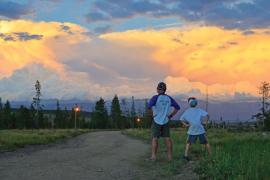Introduction
We've all looked into a group of students' eyes, as we share the intricacies of the food chain or the magnificence of the carbon cycle, and asked ourselves, "Are they getting this?" But have you ever looked beyond their eyes and into their hearts as you led them on a nature walk or uncovered critters in a tide pool and wondered how they are connecting with nature?
Experience with nature has the potential to generate an emotional connection toward nature. Especially for a child, a strong affinity toward nature can lead to not only developing environmental values and attitudes, but can also help foster positive social development. Unfortunately, our advancing technological culture appears to be driving children toward a more sedentary lifestyle spent indoors. A number of factors are responsible for the separation of children and nature.
From 1997 to 2003, there was a 50 percent decline in the amount of time spent hiking, walking, fishing, gardening, and playing at the beach by children ages nine to twelve (Hofferth and Sandberg, 2001). One of the reasons for this decrease may be that the accessibility and constant stimulation of electronic entertainment has expanded from households to children's pockets and seemingly has more appeal than outdoor play. For instance, according to Richard Louv, author and chairman of the Children & Nature Network, "In the United States, children ages six to eleven spend about thirty hours a week looking at a TV or computer monitor" (2005, p.47). Playing in nature is becoming a less familiar experience to youth.
All too often, we hear about the idealized opportunities our parents' and grandparents' generations used to have outdoors. Those opportunities appear to be minimal, less accessible, and less appealing to youth. Camps, however, have been and continue to be a reliable and available source for outdoor learning and experience with nature. This begs the question "Are these camp experiences able to increase an affinity to nature?" To help answer this question, we conducted a study to determine if participants' affinity for nature (AFN) increases due to experiencing an environmental education program. Specifically, this study investigated increases in AFN and compared these increases based on gender and language spoken in the home among the participants.
Methods
Environmental education (EE) program participants (n=529) were fifth and sixth grade students. They attended either an Outdoor School in San Luis Obispo, California, or in Cambria, California. Both programs were residential and marine science-based.
The American Camp Association Affinity for Nature "increase format" scale defined as "feelings of emotional attraction toward nature" was used. The scale measured increases in the following four domains: attraction to nature, comfort in nature, connectedness with nature, and freedom in nature (Sibthorp, 2008). At the end of the EE program, participants self-reported their changes based on the EE program. Participant responses for each item were measured using a 5 point Likert-type scale (1 = decreased; 2 = did not increase or decrease; 3 = increased a little bit, maybe; 4 = increased some, I think; 5 = increased a lot, I am sure).
The questionnaire also included items on participants' previous experiences and demographic characteristics. These included camp-related program participation, visits to Justin Schmillen, M.S., and Jeff Jacobs, Ph.D. the ocean in the last year, feelings prior to participating in the EE program, gender, ethnicity and language spoken in the home (Caucasian/English-speaking, Hispanic/ Spanish-speaking, Hispanic/Englishspeaking, and other), and residence (coastal = 5 miles or less, mid range= 6 to 40 miles, inland = 41 miles or greater). Overall AFN mean scores were examined to determine increases due to participation in the EE program. Mean differences for gender and ethnicity and language spoken on AFN were also examined.
Results
EE program participants increased in AFN (see Figure 1). Participants increased overall and on all four domains, while the attraction to nature domain increased most. Participants, regardless of gender or ethnicity / language spoken in the home saw an increase in AFN. However, results showed significant differences between AFN domains among female participants compared to males, and Hispanic/Spanish-speaking participants compared to Caucasian/Englishspeaking participants.
Discussion
This study indicated that the experience of participating in EE programs influenced positive emotional connections to nature. Similarly, previous studies with EE programs have indicated influences in behaviors (Kals, Schumacher, and Montada, 1999) and attitudes (Jaus, 1982) toward nature. Overall, participants selfassessed that between "a little bit" and "some" AFN increase took place from attending the EE program. Attraction to nature (the highest increase) could be attributed to the isolated outdoor environments of these educational experiences and might be a key component to enhancing emotional connections. Camp programmers and outdoor educators should continue to creatively exploit nature's "awe" factor, which keeps kids wanting more and engages their curiosity.
When examining gender differences in AFN, girls showed statistically greater increases in their EE experience than boys in the freedom and connectedness with nature domains and in overall AFN scores (see Figure 2). It is reasonable to consider that girls seemed to use the EE experiences to connect with and find their place in nature more so than boys. Girls may be more inclined to make emotional connections with nature than boys. On the other hand, this could provide some insight into nature-based experience barriers for females. Further assessment should be made to pinpoint if girls are not getting as many outdoor experiences as boys and, when exposed to such, if they provide "connection" and "freedom" opportunities for girls. Either way, programmers and educators may find value in facilitating outdoor opportunities for girls that are geared to explore a deeper connection with nature. Along the same line, because boys are experiencing less increase in making emotional connections than girls, it is reasonable for programmers to consider including more "freedom" and "connection" opportunities for boys in their nature experiences.
Similar to results from the American Institute of Research (2005) study of outdoor school's affects on California youth, Hispanic participants who speak Spanish at home also revealed significant differences compared to Caucasian/ English-speaking participants. Though both groups saw positive changes in AFN scores, Hispanic participants who speak Spanish at home increased more from their EE experience than Caucasian participants who speak English at home on all four AFN domains and overall. In addition, Hispanic participants that speak English in the home had significant differences in the AFN domain of freedom compared to Caucasian participants. None of the other comparisons between ethnicity and language spoken in the home groups were statistically significant (see Figure 3). Whether English- or Spanish-speaking, these results suggest that translating promotional program materials into Spanish may assist with better informing parents of the EE program opportunities.
It is also worth noting that participant AFN scores increased in both EE programs, but neither program had significant differences between each other on AFN. These results reflect that both camps had a positive influence on the participant and neither camp was outperforming one another regarding AFN increases among participants.
Further, prior feelings about the ocean and participants' previous experiences did not influence a change in AFN. This is great news for programmers! This shows that camps and EE experiences are beneficial for many despite participants' experiences. Perhaps a participant went to an outdoor camp every summer or just experienced an EE program for the first time. Regardless of prior experiences reported in the study, these influences did not affect how participants' AFN increased from their EE experience.
How This Research Can Help You
- Continue to uniquely engage campers with the beauty of nature and inspire their desire for more.
- Tailor aspects in your programming specifically for girls that explore and enhance their connection within nature. Likewise, facilitate opportunities for boys that encourage emotional connections with nature.
- Target Hispanic youth populations with nature-based learning experiences to optimize their AFN. For many, these experiences will be influential.
- Convert language in promotional materials to meet the needs of Spanish-speaking families.
- Use the AFN scale with participants to gauge your program's influence on the four AFN domains. Then, compare your results with neighboring programs and discuss what factors may be influencing positive change in the participants based on your programs.
Summary
Overall, this study revealed that environmental education (EE) program participation influences all four domains of the participants' AFN. This study revealed that female participants and Hispanic/ Spanish-speaking participants not only saw increases in AFN but also saw significantly greater increases compared to their relative groups. Results also suggested that the program a participant attends, their previous camp and learning experiences, or their prior feelings related to the environment bars no impact on AFN. The AFN scale is useful to evaluate the participant's change in emotional attraction to nature from participating in an EE program.
Acknowledgements : This research was made possible by the California Coastal Commission, through the Whale Tail Grant Program.
References
American Institute of Research. (2005). The effect of outdoor education programs for children in California. California Department of Education.
Hofferth, S., & Sandberg, J. (2001). Children at the millennium: Where have we come from, Where are we going? Oxford, England: Elsevier Science.
Jaus, H. (1982). The effect of environmental education instruction on children's attitudes toward the environment. Science Education, 66(5), 689-692.
Kals, E., Schumacher, D., & Montada, L. (1999). Emotional affinity towards nature as a motivational basis to protect nature. Environment & Behavior, 31(2), 178-202.
Louv, R. (2005). Last child in the woods: Saving our children from nature deficit disorder. Chapel Hill, NC: Algonquin Books.
Sibthorp, J. (2008). Development and validation of the affinity for nature scale for use with the ACA camper outcome battery. Martinsville, IN: American Camp Association.
Justin Schmillen is a recent graduate from Cal Poly San Luis Obispo's Recreation, Parks, and Tourism Administration Master's program. He is pursuing a future inspiring youth to explore and connect with the outdoors. Contact the author at [email protected].
Jeff Jacobs, Ph.D., is an associate professor at California Polytechnic State University, San Luis Obispo, in the Recreation, Parks, and Tourism Administration Department. Contact the author at [email protected].
Consulting Editor
Mark F. Roark's passion, heart, and desire (Ph.D.) includes more than twenty years of camp and recreation experiences. He is currently an assistant professor of recreation at Utah State University.



